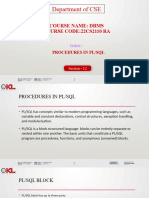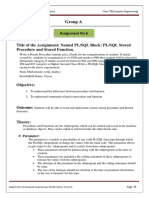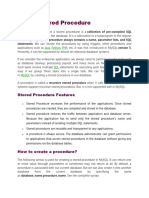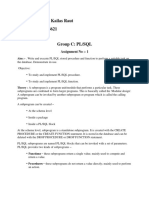0 ratings0% found this document useful (0 votes)
4 views02.basic SQL Procedure Structure
Uploaded by
Raka IrvaldoCopyright
© © All Rights Reserved
Available Formats
Download as PPTX, PDF, TXT or read online on Scribd
0 ratings0% found this document useful (0 votes)
4 views02.basic SQL Procedure Structure
Uploaded by
Raka IrvaldoCopyright
© © All Rights Reserved
Available Formats
Download as PPTX, PDF, TXT or read online on Scribd
You are on page 1/ 20
Pemrograman Basis Data
Basic SQL Procedure Structure
Tri Afirianto, S.T., M.T.
tri.afirianto@ub.ac.id
Universitas Brawijaya
Unit Objectives
• After completing this unit, you should be able to:
• Describe the structure of an SQL procedure
• Explain various clauses of the CREATE PROCEDURE
statement
• List the statements that can be coded in the procedure
body
• Alter Procedure
• Drop Procedure
• Create Module
• Replace Module
• Alter Module
• Drop Module
SQL Stored Procedures
• Based on ANSI/ISO standard language SQL/PSM
• Simple language which includes:
• Feature from block-structured language
• Exception handling
• Familiar to Sybase, Oracle, Informix, Microsoft SQL
Server programmers
SQL Procedure Language
• SQL Procedures support:
• Multiple parameters: input, output, input/output
• Returning multiple output result sets to a client or to a
calling SQL procedure
• SQL Procedures are defined in DB2 catalog
• SQL Procedure source is stored in DB2 catalog
• SQL Procedure Language (SQL PL) is folded to
uppercase – Exception: delimited values
SQL Procedure Language
SQL Procedure Language
• A CREATE PROCEDURE statement
• LANGUAGE SQL
• A procedure body which may include:
• Compound statement(s): BEGIN … END
• Declaration statements
• Assignment statements
• Conditional statements
• Iterative control structure: LOOPs, and so forth
• Exception handling
• CALL another stored procedure
Structure SQL Procedure
Structure SQL Procedure
An SQL Procedure can be:
SQL Procedure Language Statements
• Not limited to stored procedures
• Some platform differences
• Facilitate application solution
• Add business logic capability to SQL language
Where to Use “;”
Declarations
• Local variables
• DECLARE var_name datatype[ DEFAULT value];
• Example: DECLARE my_var INTEGER DEFAULT 6;
• Default value is NULL
• Variable name is folded to upper case
• Rules for ambiguous names:
• First, check to see if there is an existing column of the same name
(in one of the referenced tables)
• When a column does not exist with that name, then check to see
if there is an already defined SQL variable or parameter with the
same name
• Assumed to be a column name
Declarations
• Condition declaration:
• DECLARE not_found CONDITION FOR SQLSTATE ‘02000’;
• Local cursor declaration:
• DECLARE c1 CURSOR FOR select * from staff;
• WITH RETURN TO CLIENT / WITH RETURN TO CALLER
• Handler declaration:
• DECLARE EXIT HANDLER FOR SQLEXECPTION…;
Assignments
SQL Procedures: Under the Cover
• Preparing an SQL procedure for execution
SQL Procedures: Under the Cover
• How things work in DB2 for Linux, UNIX, and
Windows
Modules: Overview
• Module = bundle of several related objects:
• SPs, UDFs, global variables and cursors, types, conditions
• Similar to a class in OO languages (but single instance)
• Four main benefits:
• Code organization/structure
• Scoping
• CALL mySchema.myModule.myProc()
• Information hiding
• Each object can be “public” or “private”
• Global privilege control
• Instead of granting/revoking on each SP, UDF, or variable
Module: Module Specification
• Module that exports a type, a Stored Procedure,
and a User-Defined Function
• CREATE OR REPLACE MODULE myMod;
• ALTER MODULE myMod PUBLISH
• TYPE myRowTypAS ANCHOR ROW myTab;
• ALTER MODULE myMod PUBLISH
• FUNCTION myFunc(val1 ANCHOR myTab.col1)
• RETURNS myRowTyp;
• ALTER MODULE myMod PUBLISH
• PROCEDURE myProc(OUT parm1 ANCHOR myTab.col2);
Modules: Module Implementation
Modules: Other Statements
• DROP MODULE myMod;
• Drops entire module
• ALTER MODULE myMod DROP BODY;
• Drop “implementation”, keeps “specification”
• ALTER MODULE myMod DROP PROCEDURE myProc;
• Drops module object
• GRANT EXECUTE ON MODULE myMod TO joe;
• Grants user joe execute privilege on all routines and
access to all variables and types in myMod Modules
Unit Summary
Having completed this unit, you should be able to:
• Describe the structure of an SQL procedure
• Explain various clauses of the CREATE PROCEDURE
statement
• List the statements that can be coded in the
procedure body
• Alter Procedure
• Drop Procedure
• Create Module
• Replace Module
• Alter Module
• Drop Module
You might also like
- L 23 Introduction To PLSQL and Stored ProceduresNo ratings yetL 23 Introduction To PLSQL and Stored Procedures32 pages
- Advanced SQL and PL/SQL: Guide To Oracle 10gNo ratings yetAdvanced SQL and PL/SQL: Guide To Oracle 10g22 pages
- Procedures, Functions, Triggers and Packages: Objectives100% (1)Procedures, Functions, Triggers and Packages: Objectives24 pages
- Mysql Programmer Applications Database Server: Create Procedure SyntaxNo ratings yetMysql Programmer Applications Database Server: Create Procedure Syntax24 pages
- Lecture 3.1.1 - Subprogram - ProceduresNo ratings yetLecture 3.1.1 - Subprogram - Procedures18 pages
- Stored Procedures: Implementation of Business Rules Within Database Why? Improves Security, Efficiency, IntegrityNo ratings yetStored Procedures: Implementation of Business Rules Within Database Why? Improves Security, Efficiency, Integrity10 pages
- 9.Stored Procedures & Case Study - Internet BookshopNo ratings yet9.Stored Procedures & Case Study - Internet Bookshop40 pages
- Introduction To DB2 Stored Procedures: What Is A Stored Procedure?No ratings yetIntroduction To DB2 Stored Procedures: What Is A Stored Procedure?6 pages
- Oracle Academy Introduction To PL/SQL Instructor Resource GuideNo ratings yetOracle Academy Introduction To PL/SQL Instructor Resource Guide23 pages
- K. J. Somaiya College of Engineering, Mumbai-77No ratings yetK. J. Somaiya College of Engineering, Mumbai-7714 pages
- Chapter 20 - C Legacy Code Topics: 2003 Prentice Hall, Inc. All Rights ReservedNo ratings yetChapter 20 - C Legacy Code Topics: 2003 Prentice Hall, Inc. All Rights Reserved46 pages
- WideLeak: How Over-the-Top Platforms Fail in AndroidNo ratings yetWideLeak: How Over-the-Top Platforms Fail in Android9 pages
- Scenario Based Interview Questions For Java DeveloperNo ratings yetScenario Based Interview Questions For Java Developer5 pages
- AnushaN (4 5) SFDC Hyderabad Genpact RlabsNo ratings yetAnushaN (4 5) SFDC Hyderabad Genpact Rlabs4 pages
- Python_Programming_Internship_Report.pdfNo ratings yetPython_Programming_Internship_Report.pdf4 pages
- Android CardView Tutorial - CodeProjectNo ratings yetAndroid CardView Tutorial - CodeProject16 pages
- How To Create A Live Ubuntu USB Drive With Persistent StorageNo ratings yetHow To Create A Live Ubuntu USB Drive With Persistent Storage15 pages
- Childcare Center Occupancy Management Software With Early Move-Up Suggestions (1)No ratings yetChildcare Center Occupancy Management Software With Early Move-Up Suggestions (1)17 pages
- Modern Work Plan Comparison - EnterpriseNo ratings yetModern Work Plan Comparison - Enterprise9 pages
- Learn C++ by Example: Covers Versions 11 to 23 (Final Release) 1 / converted Edition Frances Buontempo download pdf100% (2)Learn C++ by Example: Covers Versions 11 to 23 (Final Release) 1 / converted Edition Frances Buontempo download pdf65 pages
- Compiler Construction: The Symbol TableNo ratings yetCompiler Construction: The Symbol Table31 pages
- Procedures, Functions, Triggers and Packages: ObjectivesProcedures, Functions, Triggers and Packages: Objectives
- Mysql Programmer Applications Database Server: Create Procedure SyntaxMysql Programmer Applications Database Server: Create Procedure Syntax
- Stored Procedures: Implementation of Business Rules Within Database Why? Improves Security, Efficiency, IntegrityStored Procedures: Implementation of Business Rules Within Database Why? Improves Security, Efficiency, Integrity
- 9.Stored Procedures & Case Study - Internet Bookshop9.Stored Procedures & Case Study - Internet Bookshop
- Introduction To DB2 Stored Procedures: What Is A Stored Procedure?Introduction To DB2 Stored Procedures: What Is A Stored Procedure?
- Oracle Academy Introduction To PL/SQL Instructor Resource GuideOracle Academy Introduction To PL/SQL Instructor Resource Guide
- Oracle Advanced PL/SQL Developer Professional GuideFrom EverandOracle Advanced PL/SQL Developer Professional Guide
- ORACLE PL/SQL Interview Questions You'll Most Likely Be AskedFrom EverandORACLE PL/SQL Interview Questions You'll Most Likely Be Asked
- Chapter 20 - C Legacy Code Topics: 2003 Prentice Hall, Inc. All Rights ReservedChapter 20 - C Legacy Code Topics: 2003 Prentice Hall, Inc. All Rights Reserved
- WideLeak: How Over-the-Top Platforms Fail in AndroidWideLeak: How Over-the-Top Platforms Fail in Android
- Scenario Based Interview Questions For Java DeveloperScenario Based Interview Questions For Java Developer
- How To Create A Live Ubuntu USB Drive With Persistent StorageHow To Create A Live Ubuntu USB Drive With Persistent Storage
- Childcare Center Occupancy Management Software With Early Move-Up Suggestions (1)Childcare Center Occupancy Management Software With Early Move-Up Suggestions (1)
- Learn C++ by Example: Covers Versions 11 to 23 (Final Release) 1 / converted Edition Frances Buontempo download pdfLearn C++ by Example: Covers Versions 11 to 23 (Final Release) 1 / converted Edition Frances Buontempo download pdf

























































































